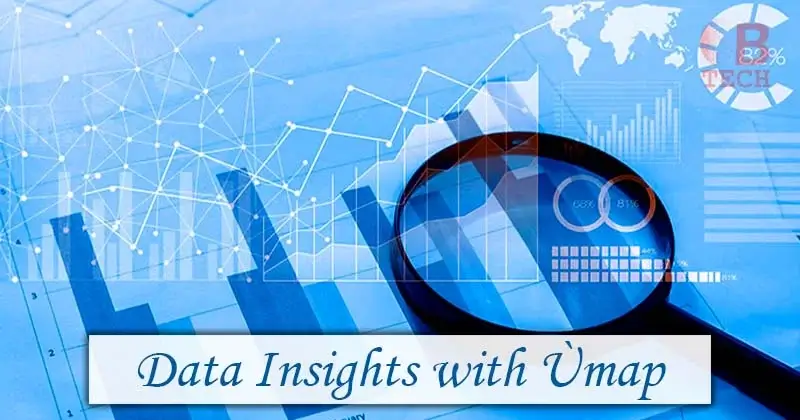Mapping the entire world onto a small map? Seems impossible, right? Well, that’s the dilemma scientists face when dealing with massive sets of data. But what if there’s a nifty tool that can unveil hidden insights within that data? Enter Ùmap. It’s becoming quite the sensation in 2024, offering a fresh perspective on data analysis.
Whether you’re a novice or a seasoned data aficionado, this guide is your ticket to mastering Ùmap. It’s designed to demystify the tool and empower you to extract deeper meaning from your data.
Ready to dive in and unlock the secrets hidden within your datasets? Let’s explore Ùmap together!
What is Ùmap?
Ùmap, short for Uniform Manifold Approximation and Projection, is a powerful tool for unraveling complex data. Think of your data as a knotted tangle of vibrant yarn—it’s a mess that’s hard to decipher. Ùmap steps in like a skilled artist, deftly untangling that yarn into a clear picture. It simplifies the data, unveiling patterns and connections that were previously obscured.
How does it work?
Ùmap works its magic by simplifying complex datasets, making them easier to interpret. It’s like turning a chaotic ball of yarn into a tidy image. This process reveals hidden insights and structures within the data, making it more understandable and actionable.
Why is it useful?
Understanding your data is crucial across various fields, whether it’s biology, finance, or marketing. Ùmap’s ability to clarify and simplify complex datasets makes it an invaluable tool for researchers, analysts, and professionals seeking deeper insights into their data.
Origin of Ùmap
Back in 2018, Ùmap burst onto the scene as a game-changer in data analysis. It was the brainchild of Leland McInnes, John Healy, and James Melville, who aimed to revolutionize dimensionality reduction techniques. Their groundbreaking research paper, titled “Uniform Manifold Approximation and Projection for Dimensionality Reduction,” introduced the world to a new approach that aimed to surpass existing methods like t-SNE.
Evolution of Ùmap
Initially, Ùmap caught the attention of data enthusiasts and researchers within the field. It was supported by libraries such as UMAP and sci-kit-learn, laying the foundation for its growth. Over time, refinements were made to enhance its capabilities, including adaptive distance weighting and landmark selection, making it even more effective at untangling complex datasets.
Rise in Popularity
From 2022 onward, Ùmap experienced a meteoric rise in popularity. This surge can be attributed to several factors, including the escalating complexity of data, the development of user-friendly tools, and the impressive results showcased across various applications. As a result, Ùmap solidified its position as the go-to method for visualization and analysis, garnering widespread adoption across diverse industries.
Benefits of Using Ùmap
Preserves Data Structure
Unlike other methods, Ùmap excels at maintaining the structure of your data. It accurately portrays relationships between data points, even in simplified representations, allowing for a clear understanding of how elements are connected.
Handles Large Datasets Efficiently
Dealing with massive volumes of data can be daunting, but Ùmap rises to the challenge with its speed and efficiency. It’s adept at processing large datasets, making it indispensable for real-world projects where extensive data analysis is required.
Versatility Across Different Data Types
Ùmap is versatile when it comes to data types. Whether you’re working with images, text, or numerical data, Ùmap can handle it all. It transforms diverse datasets into meaningful visual representations, providing valuable insights regardless of the data format.
Produces Clear and Appealing Visualizations
One of Ùmap’s standout features is its ability to create visually appealing representations of data. The generated visualizations are not only aesthetically pleasing but also easy to comprehend. This visual clarity enables users to identify patterns and trends effortlessly and facilitates effective communication of findings to non-experts.
User-Friendly Interface
You don’t have to be a data expert to leverage the power of Ùmap. With user-friendly tutorials and tools available, it’s accessible to anyone interested in data analysis. Whether you’re a novice or an experienced analyst, Ùmap offers a straightforward approach to exploring and interpreting data, making it a valuable asset in various fields and industries.
How to Master Ùmap Like a Pro?
1. Understand Your Data
Before diving into Ùmap, take time to understand your data thoroughly. This understanding will guide your parameter choices and interpretation, ensuring meaningful results.
2. Experiment with Hyperparameters
Don’t hesitate to experiment with hyperparameters like n_neighbors and min_dist to optimize your results. Adjusting these parameters can significantly impact the outcome of your Ùmap visualization.
3. Explore Diverse Metrics
Explore a variety of metrics, such as cosine similarity, to unveil hidden structures within your data. Experimenting with different metrics can lead to new insights and perspectives.
4. Consider Higher Dimensions
Consider working with higher dimensions to access richer information within your data. Combining techniques like PCA or clustering with Ùmap can provide deeper insights into complex datasets.
5. Customize Visualizations
Customize your visualizations by adding informative labels and selecting suitable color palettes. Clear and visually appealing visualizations enhance communication and understanding of your findings.
6. Validate Results
Validate your Ùmap results using techniques like silhouette analysis. This ensures the reliability and accuracy of your visualizations, providing confidence in your conclusions.
7. Engage with the Community
Stay connected with the vibrant Ùmap community to stay updated on the latest developments and techniques. Engaging with peers allows for knowledge sharing and collaborative learning opportunities.
8. Practice and Share Knowledge
Practice using Ùmap with different datasets to hone your skills. Additionally, share your knowledge and experiences with others to help them master this powerful data analysis tool.
By following these pro tips and actively engaging with Ùmap, you can unlock its full potential and become proficient in leveraging its capabilities for insightful data analysis.
Applications of Ùmap
Biology and Genomics
Ùmap finds extensive use in visualizing gene expression data, analyzing single-cell genomics, and understanding protein-protein interactions. It aids researchers in unraveling complex biological processes and identifying patterns within genomic datasets.
Finance and Marketing
In the realm of finance and marketing, Ùmap is instrumental in customer segmentation, fraud detection, and analyzing stock market trends. By clustering customers based on their behavior and detecting anomalies in financial transactions, Ùmap helps businesses make informed decisions and mitigate risks.
Image and Text Analysis
Ùmap proves invaluable in image and text analysis tasks such as image content understanding, document clustering, and sentiment analysis. It facilitates the organization and interpretation of vast amounts of visual and textual data, enabling insights into trends and sentiments.
Other Applications
Beyond specific domains, Ùmap finds applications in diverse areas including social network analysis, recommender systems, and scientific research. It offers a versatile toolset for exploring complex datasets and uncovering hidden patterns in various contexts.
Capabilities of Ùmap
Handling High-Dimensional Data
Ùmap excels at handling high-dimensional data effectively, making it suitable for analyzing datasets with numerous features or dimensions. Its ability to navigate complex data structures enables comprehensive exploration and interpretation.
Preserving Global Structure
One of Ùmap’s key strengths is its accuracy in preserving the global structure of data. By maintaining the overall relationships between data points, it ensures that insights derived from visualizations are reliable and representative of the underlying dataset.
Producing Interpretable Results
Ùmap generates visualizations that are not only visually appealing but also interpretable. Its ability to translate complex data into intuitive representations facilitates understanding and decision-making, even for non-experts.
Efficiency and Scalability
With its efficient algorithms and scalable architecture, Ùmap demonstrates remarkable performance in data analysis tasks. Whether dealing with small datasets or large-scale analyses, Ùmap delivers results in a timely and resource-efficient manner.
Getting Started with Ùmap
1. Choose Your Tools Wisely
Select the appropriate tools for your Ùmap implementation. Popular choices include Ùmap (Python) and sci-kit-learn (Python). Make sure these tools are installed and your coding environment is properly configured.
2. Gather Clean Data
Before diving into Ùmap, ensure your data is clean and well-prepared. Preprocess the data to handle missing values, outliers, and any other irregularities. Understand the characteristics of your data and anticipate potential challenges that may arise during analysis.
Let’s Code
Begin by importing the necessary libraries for your Ùmap implementation. Import Ùmap itself along with your chosen Python library (such as sci-kit-learn) and any additional functionalities required for data manipulation and visualization.
Instantiate the Ùmap Object
Initialize a Ùmap object in your code, specifying parameters such as the desired number of components (n_components). This step sets the stage for training the Ùmap model on your data.
Fit the Model
Utilize the fit method to train the Ùmap model on your preprocessed data. This step involves feeding your data into the model and allowing it to learn the underlying structure.
Transform Data
Once the model is trained, employ the transform method to project your data onto a lower-dimensional space. This transformation simplifies the data while preserving essential relationships, facilitating visualization and analysis.
Visualize Results
Utilize visualization libraries like Matplotlib or Plotly to create insightful visualizations of your Ùmap results. Plot the transformed data in a clear and compelling manner, allowing for easy interpretation and further exploration.
By following these steps, you can kickstart your journey with Ùmap and begin exploring and analyzing your data effectively.
Challenges and Opportunities in the Ùmap Landscape
Challenges
1. Interpretability
Understanding and interpreting the low-dimensional representation created by Ùmap can pose challenges. This lack of clarity can limit trust in the results and hinder deeper analysis of the data.
2. Parameter Tuning
Selecting the right parameters for Ùmap can be difficult, especially for beginners. Incorrect parameter choices may result in misleading visualizations and analyses, complicating the process for users.
3. High-dimensional Data
Dealing with extremely high-dimensional datasets presents challenges for Ùmap. Such datasets can impact both the performance and interpretability of the technique, posing obstacles to effective analysis.
Opportunities
1. Explainable AI
Research into explainable AI techniques tailored specifically for Ùmap holds promise for enhancing interpretability and fostering trust in the generated results. This could lead to clearer insights and more confident decision-making.
2. Automated Parameter Tuning
Developing automated tools for parameter tuning in Ùmap would greatly benefit users, particularly those who are less experienced. Streamlining this process could make Ùmap more accessible and user-friendly.
3. Addressing Extreme High-dimensionality
Continued research efforts aimed at optimizing Ùmap for handling high-dimensional datasets are crucial. Finding ways to mitigate the challenges associated with extreme high-dimensionality would enhance the technique’s effectiveness and applicability.
4. Streamlined Integration
Efforts to seamlessly integrate Ùmap with machine learning pipelines would open up opportunities for more comprehensive applications and streamline workflows. This would enable users to incorporate Ùmap into their existing data analysis processes more efficiently.
The Promising Future of Ùmap
In the future, expect advancements in Ùmap geared towards enhancing interpretability. Explainable AI techniques and interactive visualization tools will shed light on the underlying processes, making the results more understandable and trustworthy.
Improved Parameter Tuning Techniques
Brilliant parameter tuning techniques are on the horizon for Ùmap. Automated optimization and data-driven tuning methods will simplify the process of selecting parameters, making it more accessible to users of all levels of expertise.
Research into Novel Algorithms
Research efforts will focus on developing novel algorithms for Ùmap, addressing scalability issues and enabling efficient analysis of vast, high-dimensional datasets. These advancements will unlock new possibilities for exploring complex data structures.
Streamlined Integration and Workflow
Standardized integration frameworks and domain-specific UMAP libraries will streamline workflows, making it easier to incorporate Ùmap into existing data analysis pipelines. This seamless integration will enhance efficiency and usability across various domains.
Workforce Optimization Software Eleveo
Continued Innovation and Collaboration
Evolving applications across diverse fields and a collaborative UMAP community will drive ongoing innovation and adaptation. By staying at the forefront of data analysis and visualization, Ùmap will continue to meet the evolving needs of users and remain a valuable tool in the data science toolkit.
Frequently Asked Questions About Ùmap
1. What Sets Ùmap Apart from Other Dimensionality Reduction Techniques?
Ùmap stands out from traditional methods by prioritizing the preservation of global structure in complex, high-dimensional datasets. This unique approach enables it to capture intricate relationships between data points more accurately.
2. How Do I Choose Ùmap’s Parameters Effectively?
Effective parameter selection depends on factors such as your data characteristics and analysis goals. Begin with default parameters and fine-tune them through experimentation and a deep understanding of your dataset.
3. Can Ùmap Handle Large Datasets?
Yes, Ùmap is designed to efficiently process large datasets. However, challenges may arise when dealing with extremely high-dimensional data, requiring careful consideration and optimization.
4. Is Ùmap Suitable for Specific Fields or Applications?
Ùmap’s versatility makes it applicable across various fields and domains, including biology, finance, image analysis, and more. Its ability to uncover hidden patterns and structures in data makes it valuable in diverse applications.
5. How Do I Interpret Ùmap Results?
Interpreting Ùmap results involves understanding the relationships and clusters formed in the reduced-dimensional space. Visualization techniques and domain expertise play key roles in deciphering the insights derived from Ùmap visualizations.
Sum Up
Ùmap represents a revolutionary approach to data analysis, offering unparalleled insights into complex datasets. With its ability to untangle intricate relationships and reveal hidden patterns, Ùmap empowers users across various fields to make informed decisions and drive innovation.
Also Read: RDBS (Relational Database System)



